
Kane & Ross Blog
Read the latest articles from Kane and Ross below.
Babies: Nutritional Needs
Apr 27, 2025
The BBC today have published a report on the nutrition provided by baby pouches which are increasingly popular in the UK. Please take a look and share the link below with friends so they’re aware of the issue with how these pouches are marketed.
See the BBC report at https://www.bbc.co.uk/news/articles/c62j0l0gg4go
Protect Yourself at Work
Mar 17, 2025
Maintaining correct sitting posture is important to avoid low back pain, neck pain, headaches and shoulder pain.
- Tilt the base of your seat – keep hips slightly above knee level.
- Stay in an upright position right at the back of your chair.
- Keep feet flat on the floor – get a footrest if needed.
- Keep screen at eye level, an arm’s length away and directly in front of you.
- Use a laptop slope with separate keyboard and mouse.
- Keep elbows supported at 90 degrees.
- Keep wrists in a neutral position.
- Keep everything you use regularly within arms reach.
- Alternate activities between sitting and standing.
- Keep a bottle of water at your desk.
More information can be found about how we can help you at http://www.kaneandross.co.uk
- Do the below stretches hourly
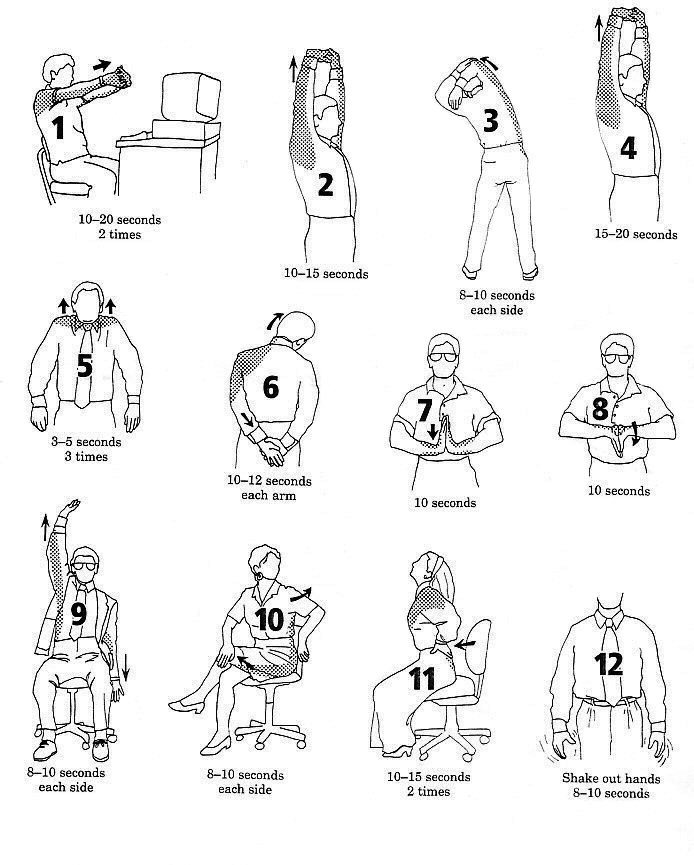
Desk Posture: It’s Simple
Jan 16, 2025
National press, including the BBC, have in the past promoted reports advocating that office workers should sit in a ‘slouched back’ position. This is said to relieve pressure on the back.
Although these recommended slouched positions may unload the spine, most people have a tendency to slip down causing increased pressure on the posterior ligaments, resulting in back pain.
As Simone says, ‘The trouble is, this position will cause you to slouch eventually, stretching the posterior muscles of the lower back. It will almost certainly result in long term instability and support for your lumbar spine’
So what is the right way to sit? We advise tilting the base of your chair forward to put your pelvis in a good sitting position which makes the angle approximately 120 degrees. Do make sure that your screen and keyboard are aligned and directly in front of you. You should also get up and walk around every 30 minutes.
More information can be found about how we can help you at https://www.kaneandross.co.uk

Reducing neck and back pain symptoms for office based workers
Jan 13, 2025
Posture related neck, headache and back pain are common symptoms that we see as osteopaths at Kane & Ross Clinics, particularly those patients who are sitting for many hours either at a PC, laptop or tablet.
Pain results from the muscles in the neck, shoulders and back getting over-tired as they’re not held in their most natural position. Waste products build up as the muscles are over stretched or shortened and an alteration to the blood flow in the muscle occurs leading to aches and pains.
These symptoms can be helped through osteopathic treatment, exercise and good ergonomic advice.
Even if the workplace provides the option for a work station assessment, it is essential that you sit in your chair in the most supportive way – otherwise neck and back pain symptoms are likely to persist.
Advice on how you can help prevent these posture related pain
– Sit in a supportive office chair with your knees bent at 90 degrees with both feet flat on the ground. Elbows should be bent at 90 degrees with the forearms supported by the desk height. Alter the chair height to accommodate these angles. If your feet do not then touch the floor then use a foot rest to support your lower limbs with the feet flat (avoid angled foot rests). Tilt the base of the chair forward so that your knees are below your hips.
– ensure you sit upright up against the back of the chair with a good lumbar support avoiding slumping the shoulders forward and tucking your chin in
– sit evenly on both buttocks do not cross your legs.
– ensure your computer screen is at eyebrow height, if you are using more than one screen use a plastic mat under your chair and that your main computer screen is directly in front of you. If you can use less screens, do.
– If you use a laptop, use an external keyboard and mouse and place your laptop screen at eye level on a screen stand.
– If you use a tablet users, take regular breaks every 30 minutes and avoid using when sitting in bed / sofa and stand on a table / desk.
– For all desk workers, we recommend taking regular breaks every 30 minutes.
– If you have headaches, neck pain or back pain, get a diagnosis , so that you can find out what the specific problem is and how to deal with it.
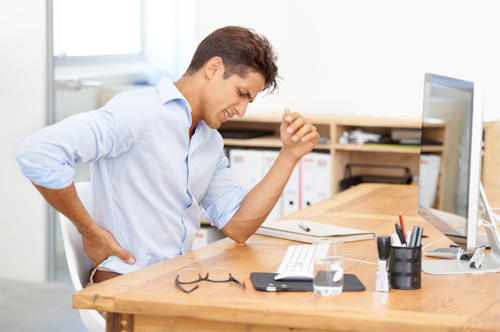
Anyone For Tennis? Osteopathy and Common Tennis Injuries
Jan 11, 2024
With Wimbledon now in full swing, tennis courts are the busiest they have been all year. Whether you play avidly all year round or dust off your racket only for the summer months, all tennis players have similarities and susceptibility to injury.

It is not just the direct strain that the body goes through when serving, spinning, smashing and sledgehammering the ball that causes musculoskeletal pathology. There are many factors that are often overlooked that may predispose injury and contribute to the manifestation of pain. Osteopathic management offers a full assessment of your biomechanics to find the underlying cause for pain that you are experiencing. Using a range of manual techniques such as soft tissue and articulation we treat acute injuries and acute and chronic pain. We also offer advice on self management and how to prevent recurrent injury.
In tennis and other racket sports our joints and the soft tissues surrounding them are particularly prone to overuse injuries due to the repetitive motions required when playing. Tennis players are also prone to traumatic injury due to the fast pace of a game, changing direction quickly and stopping and starting.
As osteopaths we commonly see traumatic injuries to the lower limb and repetitive strain injuries to the upper limb associated with racket sports. In the lower limb ankle strains and sprains and knee injuries are among the most prevalent. In the upper limb overuse injuries are seen in the wrist, elbow and in the shoulder. The most notorious repetitive strain injury is ‘tennis elbow’ or Lateral epicondylitis as it is more formally known, with the overall incidence of this injury in tennis players reported to be between 35 – 51%. Other common injuries associated with tennis are carpal tunnel syndrome, rotator cuff tendonitis, achilles tendonitis and back pain.
If anything is holding you back this season, please don’t hesitate to contact us. Find more information on how we can help you at https://www.kaneandross.co.uk.

What is “tennis elbow”?
In the forearm there are many small muscles. Most of these attach to the bony prominences of the elbow (the epicondyles), these are at the end of the humerus also known as the funny bone! These small muscles act to flex and extend the wrist as well as to stabilise it. Lateral epicondylitis is the inflammation of the tendons of these small extensor muscles causing pain at their attachment point on the lateral epicondyle of the elbow. Particularly the tendon of the extensor carpi radials brevis muscle. Pain is experienced due to both inflammation and periosteal irritation, where the surface of the bone is irritated.
Tennis Elbow can arise from the repetitive movement of the wrists causing weakening to the extensor muscles and subsequent damage and inflammation as described above. There is a high incidence of lateral epicondylitis in tennis players due to the repetitive movement and increased contraction of the extensor muscles when performing the backhand stroke.
St Mary’s needs some help
Nov 12, 2023
Simone and Mark and the rest of the team have worked for many years with babies and children who have been born at St. Mary’s or who have needed their expert care.
Over the last 20 years we have excellent working relationships with many of the doctors and consultants there. They really need your help with increasing the size of the intensive care unit so that more families and children can be helped and that existing families have more privacy.
Please have a look at the following video: https://vimeo.com/140047364
Newborn Specialist training – Update from Simone Ross
Sep 12, 2023
I have really enjoyed the teaching sessions that I have started to run in Harley Street for newborn specialists. Discussions involved the most common conditions that babies present with in the clinic. The newborn specialists are familiar with these conditions and are in an ideal position to recognise symptoms early so preventing any long term complications. Osteopathy can often help these conditions but an integrated approach with specialists or parents will give optimum treatment for the babies. It was great to discuss and share experiences together. Thank you for all your positive feedback.
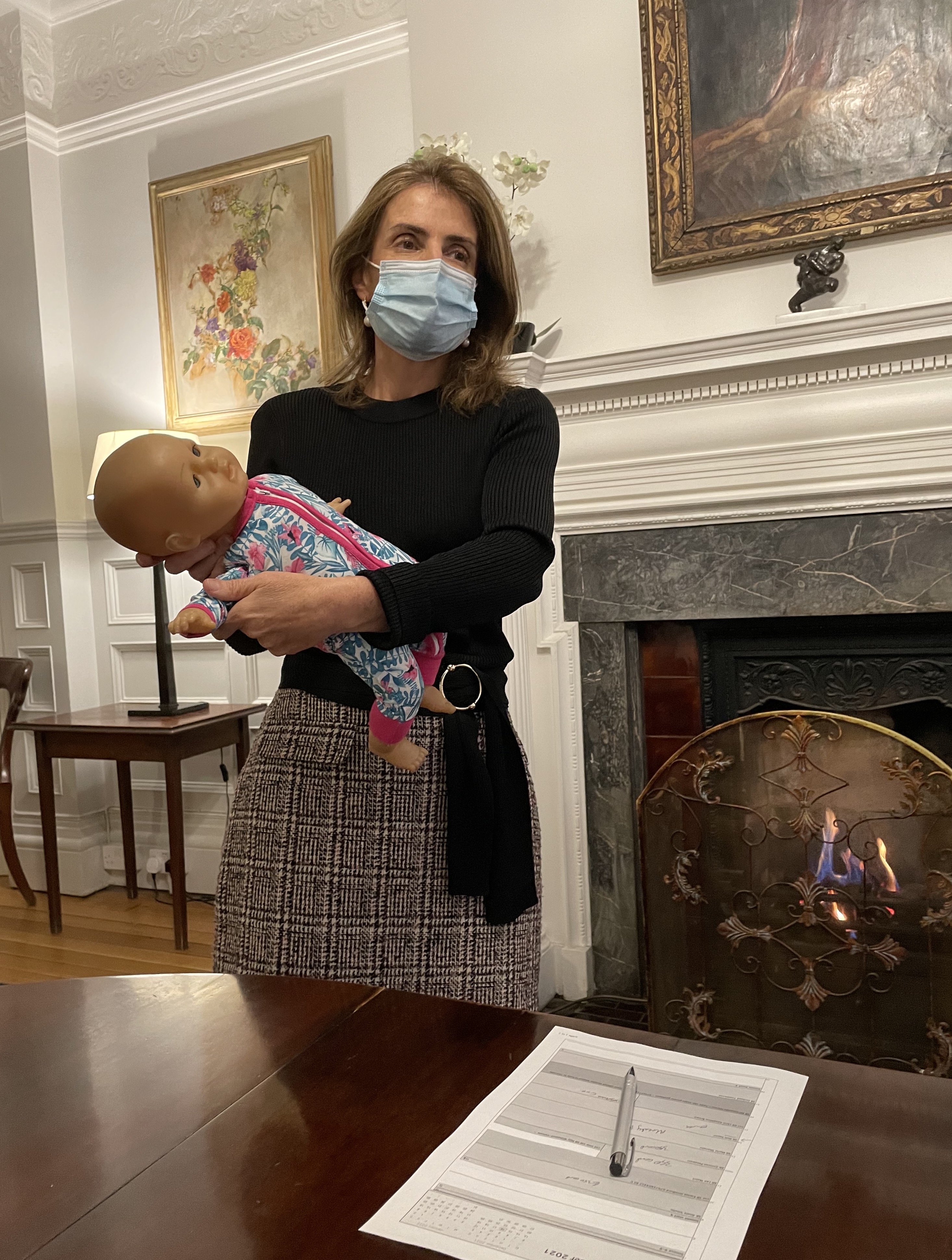
Avoiding Acute Parental Injuries: Bupa Guide
Jul 1, 2023
New research has found that more than 80,000 Britons a year injure themselves incorrectly lifting or carrying youngsters. In response to this recent research BUPA has produced an illustrated guide showing parents how to lift young children safely to avoid pain. This can be downloaded via the following link: https://bupa.co.uk/parentalpains
As a family centred practice our osteopaths at Kane and Ross often see patients with back pain, knee pain and other joint pain caused by incorrectly lifting, carrying or changing babies, toddlers and young children. We also see many mothers experiencing back pain and neck pain from poor breast breastfeeding posture.
If you have any concerns or if you are experiencing musculoskeletal pain please don’t hesitate to contact the clinic on 020 7436 9007 or send an email to info@kaneandross.co.uk.
Marylebone Journal June/July 2017: The life and times of Simone Ross
Jun 10, 2023
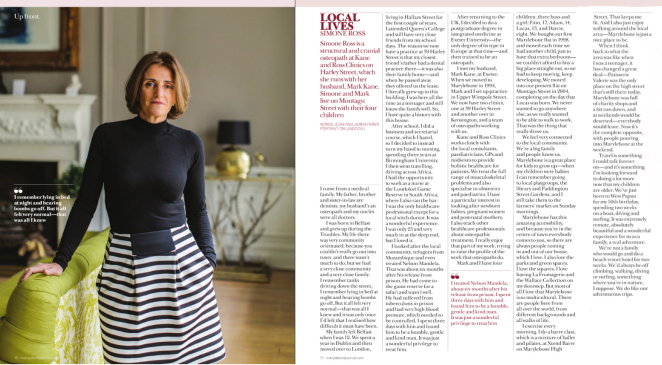
The Marylebone Journal is a local lifestyle magazine with articles that focus on the Marylebone community. Building community relationships is very important to Simone both around our practice in Courtfield Gardens and around Harley Street. Recently they interviewed Simone.
Here is the article: https://ibb.co/jFgZDF
Give babies peanut butter to cut allergy by 77%, study says.
Mar 25, 2023

An article appeared on the BBC news website on 18th March that we thought was worth bringing to the attention of our patients.
Link here: https://www.bbc.co.uk/news/health-64987074
Give babies peanut butter to cut allergy by 77%, study says
By James Gallagher
Health and science correspondent
Giving young babies – between four and six months old – tiny tastes of smooth peanut butter could dramatically cut peanut allergies, say scientists.
Research shows there is a crucial opportunity during weaning to cut allergy cases by 77%.
They say the government’s advice on weaning – which says no solids until around six months – needs to change.
Experts warn whole or chopped nuts and peanuts are a choking risk and should not be given to children under five.
The current NHS guidance does say peanut (crushed, ground or butter) can be introduced from around six months old.
A baby is ready for their first solid food if:
- they can stay in a sitting position, holding their head steady
- co-ordinate their eyes, hands and mouth so they can look at their food, pick it up and put it in their mouth
- swallow food, rather than spit it back out
Why do food allergies happen?
Peanut allergy has been rising in the UK with an estimated one-in-50 children now affected.
Food allergies are the result of our immune system mistaking something harmless for a severe threat.
For some, even a small amount of peanut can lead to such an overwhelming immune reaction that it becomes life-threatening.
Peanut allergy has become so common that some schools ban the ingredient.
There had been long-standing advice to avoid foods that can trigger allergies during early childhood. At one point, families were once told to avoid peanut until their child was three years old.
However, evidence over the last 15 years has turned that on its head.
Instead, eating peanut while the immune system is still developing – and learning to recognise friend from foe – can reduce allergic reactions, experts say.
It also means the body’s first experience of peanut is in the tummy where it is more likely to be recognised as food rather than on the skin, where it may be more likely to be treated as a threat.
Israel, where peanut snacks are common in early life, has much lower rates of allergy.
Other studies have suggested introducing other foods linked to allergies – such as egg, milk and wheat – early also reduced allergy.

The latest research, published in the Journal of Allergy and Clinical Immunology, calculated when is the best time to start introducing foods containing peanut.
The analysis was conducted by the University of Southampton, King’s College London and the research arm of the NHS – the National Institute for Health and Care Research.
They found the critical period to start was between four and six months, during which the allergy could be cut by 77%.
That is the equivalent of preventing 10,000 out of the roughly 13,000 cases of peanut allergy each year.
Delaying the introduction of peanut-based foods until the child was one-year-old would only cut allergy cases by 33%, according to the research.
For babies with eczema, which is a risk factor for allergy, the investigators recommend starting at four months – as long as the baby is ready.
They say parents should start by offering small amounts of fruit or vegetables.
Then when the baby is comfortable, around three heaped teaspoons of peanut butter a week should be introduced and maintained for years. Peanut butter, which can be quite dry, can be given with breastmilk.
Prof Graham Roberts, from the University of Southampton, said decades of advice to avoid peanut had “understandably led to parental fear” of giving children peanut and shifting rules led to large amounts of confusion from both within medicine and from parents.
However, he said this was a “simple, low-cost, safe intervention” that would “deliver vast benefits for future generations”.
Official advice is to start offering solid foods alongside milk at around six months old, and the government has launched a campaign on the correct time to wean due to parents starting earlier.
Osteopathic advice for mountain-goers: Injury prevention and damage limitation
Jan 21, 2023

At this time of year as Osteopaths we see many people that have returned from their mountain adventures with ski or snow sport related injuries.
Regardless of whether you are skiing, snowboarding, snowshoeing or simply enjoying the après-ski, a week in the mountains is physical both on and off-piste and your endurance is likely to be tested. Make the most out of your trip, ensure you have the right equipment and be physically prepared!
Most snow sports require strength, flexibility, balance, and muscle control. As most of us do not ski regularly, we are likely to experience muscle soreness after a couple of days on the slopes. Muscle soreness may cause some loss of muscle control, increasing the likelihood of injury. To support adaptability and enhance your technique, we advise that you start to strengthen your muscles prior to your trip.
If you are experiencing musculoskeletal pain before you go away, don’t ignore it! An existing problem is likely to predispose an injury. Osteopathic management offers a full assessment of your biomechanics to help prevent further pain, and advice will be given on how to best support the area of dysfunction.
Patients often come into the clinic with the following injuries after a skiing holiday:
- Muscle strain due to overuse
- Damage to the ligaments or cartilage of the knee due to twisting and changing direction
- Rotator cuff muscle and shoulder injuries
- Thumb, hand and wrist injuries
-
Whiplash
- If you have returned from the mountains a little worse for wear, or if you have any concerns, please contact the clinic on 020 7436 9007 or email info@kaneandross.co.uk to discuss how we can help you.
Strengthening Exercises
Squats and Lunges
When skiing, the quadriceps (the group of muscles at the front of your thighs) are constantly engaging as we bend our knees and lean our body weight forwards in our ski boots.
Squats
Stand against a wall, keep your back straight and bend your knees to a 90degree angle so that you are in a sitting position. Hold this position for 10 seconds and repeat 10 times.
If you would rather perform standard squats to strengthen, ensure that your knees, hips and toes are in alignment, make sure that your back is not arched and keep your buttocks above knee level.
Lunges
Lunges are also good to strengthen. Stand with your feet about hip-width apart and engage your abdominal muscles. To initiate your lunge, take a big step forwards. Both knees should be at a 90degree angle as you lunge down and keep your back knee off the ground.
Glut Bridges
When skiing downhill your upper body is normally held in flexion. In this position your glutei (buttock muscles) and hamstrings (at the back of your thigh) have to work hard to counterbalance.
Lie on your back with your knees bent and you feet flat on the floor. Lift your hips off the ground until your knees, hips and shoulders form a straight line. Engage your glutei and abdominal muscles and hold the position for 10 seconds.
Heel Raises and Calf Stretching
Strengthening and increasing the flexibility of your gastrocnemius and soleus (the muscles in your calf) will be of benefit as these help to stabalize and keep you upright!
Heel Raises
Standing near a wall for balance, place your feet hip-width apart and make sure your ankles, knees and hips are in alignment. Press down into the balls of your feet to raise your body upwards.
Stretching
Stand facing a wall with your hands flat against it. Place the leg to be stretched back behind you, keeping your back knee straight, lunge forwards on your front leg until you feel a stretch in the back leg.
Alternatively, sit on the floor with the leg to be stretched extended forwards, bend the other leg and place your foot on the floor. Using a band, towel, or your hand if you can reach, pull the toes toward you. Hold for 10 to 20 seconds then repeat on the other side.
Diagnostic Ultrasound at Kane and Ross Clinics
Dec 17, 2022
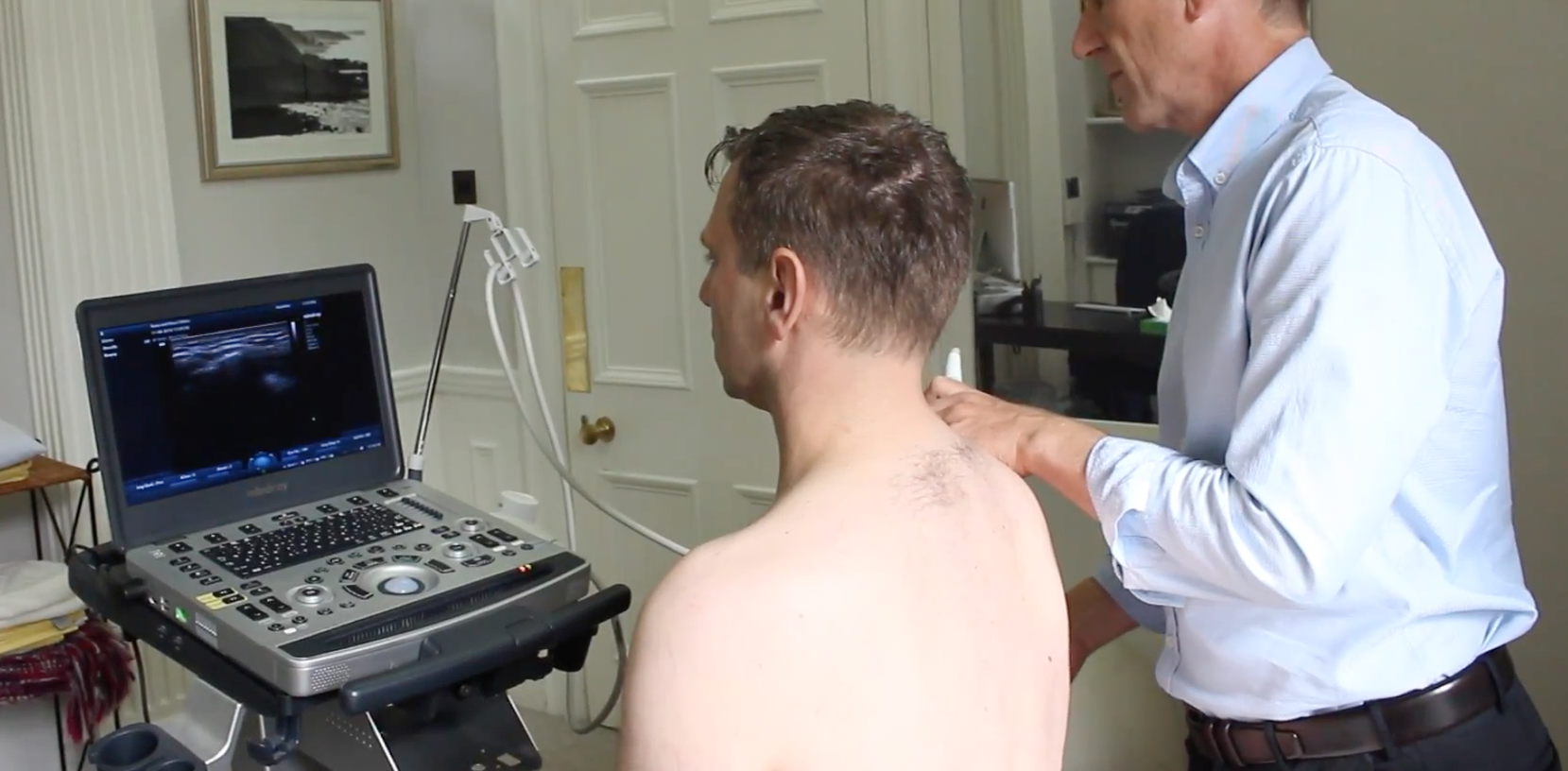
Kane and Ross is one of the only practices in London to offer musculoskeletal diagnostic ultrasound with osteopathic treatment. This not only allows us to confirm a clinical diagnosis but also allows us to monitor tissue repair enhancing our osteopathic treatment and management strategies.
What is diagnostic ultrasound and how does it work?
Ultrasound is a diagnostic imaging technique used to generate real time images of specific areas of the body. It works by sending ultrasound waves through the body using a transducer. When these sound waves reach boundaries between our tissues (for example the boundary between soft tissue and bone) they are reflected. This produces an electrical signal that goes to a scanner and an image is produced!
How is diagnostic ultrasound used in Osteopathy?
Diagnostic Ultrasound is a quick, safe, painless procedure that enables the osteopath to accurately diagnose problems of the soft tissues.
It can be particularly helpful in establishing an accurate diagnosis of the following musculoskeletal conditions and pathologies that we as osteopaths see in everyday practice:
Shoulder -rotator cuff problems -tears inflammation, bursitis, tendinitis, impingement
Elbow – tendon problems such as tennis or golfers elbow (not only in tennis or golf players)
Wrist/Hand -carpal tunnel syndrome, repetitive strain injuries, ganglion cysts, arthritis
Hip – hernia, bursitis, tendon problems, arthritis
Knee – problems of the tendons, ligaments, bursa, bakers cyst, signs of meniscal damage
Ankle – achilles tendon: tears and inflammation, tenosynovitis, arthritis, ligament damage
Foot– plantar fasciitis, morton’s neuroma, arthritis, tendinitis
If you would like more information about diagnostic ultrasound at Kane and Ross or on how we can help you, don’t hesitate to contact the clinic. You can call us on 020 74369007 or send an email to info@kaneandross.co.uk
Safely swaddling: Keeping your baby settled
Nov 9, 2022
BBC News has commented on the problems of hip dysplasia in babies who are swaddled. The problem with this is if your baby is much more settled when they are swaddled, what should you do? For those babies who are much more content swaddled and sleep better you can still swaddle the top half of their bodies tightly but leave the legs and hips so they can move around. It is usually the arms that wake the baby up.
So wrap the top half of their bodies as you normally would, tucking in the blanket and securing the arms.
Then take the lower half of the blanket, just gently wrap the legs, the baby should be able to move them and lift the knees up. Twist the bottom of the blanket and either gentle tuck in under the baby’s legs or wrap around the legs. You should be able to see the baby’s legs move.
The video at this link demonstrates the swaddling technique we advise you to use.
More information can be found about how we can help you at https://www.kaneandross.co.uk
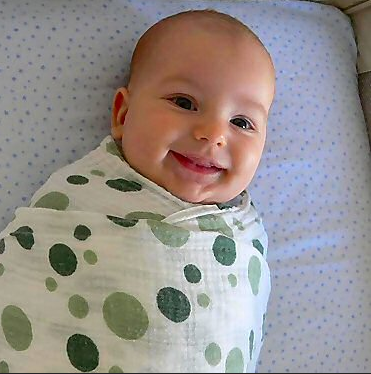
Back Pain: 9 Essential Tips
Nov 8, 2021
These are our Essential Tips for preventing and dealing with Back Pain. Let us know if you have others that you would like to share.
- Keep your core strong – your lower abdominals, pelvic floor, spinal muscles
- Keep your weight down – remember a moment on the lips forever on the hips and as you get older it is far more difficult to lose
- Get your ergonomics sorted at work – it is much better to be preventative than have treatment
- Exercise at least 3-4 times per week
- Work less on an iPad, laptop than on a desk top
- Do not hyperventilate – breathe well
- When you are sore more than 3 times a week or on a regular basis, get a diagnosis
- Work preventively – come for treatment when you feel the pain coming rather than when you are acute – you will need less
- Look after yourself – no one else will!
More information can be found about how we can help you at http://www.kaneandross.co.uk
Our simple do’s & don’ts during pregnancy.
Aug 17, 2021
DO
Continue with your exercise programme until advised to stop or modify your routine – the fitter you are the easier your pregnancy and delivery will be!
Exercise to strengthen the back and pelvis and to open the ribs.
Lift carefully by bending your knees and limit the amount of weight you carry.
Keep your pelvis above your knees when sitting.
Lie on your side when relaxing on the couch.
Put a pillow between your legs and under your bump when lying in bed.
Take walks after dinner and have small meals in the evening if you are suffering from heartburn.
Get someone to look at your ergonomics if you work in an office.
DON’T
Stand in one position for too long, stick your bump out or wear high heels.
Cross your legs when seated.
Lift and twist putting additional strain on your back.
Sit for more than 20 minutes at a time.
Slouch when sitting on the couch.
Get a massage if you are in pain. Specialist help will be much more beneficial.
Drink coffee, tea or eat red meat, oranges or tomatoes if suffering from heartburn.
Hyperventilation Syndrome
Jul 20, 2021
Hyperventilation syndrome a name given to a collection of symptoms cause by over-breathing. It is very common, especially in females, asthmatics and those aged 15-55.
When we breathe more quickly and more shallowly than our bodies require, physical changes take place within our body. The level of carbon dioxide in your blood decreases, causing the blood to become more alkaline.
Symptoms of hyperventilation syndrome vary from individual to individual, but can include…
- Shortness of breath, tightness through the chest and frequent sighing.
- Tingling or numbness in your arms, fingers, toes or around your mouth.
- Dizziness, headaches and feeling faint.
- Palpitations and an increased heart rate.
- Cold hands and feet, and shivering
- Sickness and abdominal pain
- Feeling stressed, tense or anxious
Chronic hyperventilation is generally due to prolonged stress, such as work problems, a bereavement in the family or after a traumatic incident, such as a car crash.
When faced with prolonged stress, the muscles in the upper body tend to become tense. As the nerves supplying the diaphragm originate in this area of the body, this can lead to the diaphragm becoming tight and not functioning fully, leading to the upper thoracic muscles being used for breathing, and causing breathing to become quicker and shallower.
An osteopath will assess your breathing and how your ribs and diaphragm are working. If they believe that you are suffering from hyperventilation syndrome, they may work on your thoracic spine, your diaphragm and your ribs. They may also work on your neck, where the nerves to the diaphragm originate from. They may also give you breathing and relaxation exercises, to help your breathing become slower and deeper.
Simone Ross writing for Harper’s Bazaar: ‘We cannot recommend her highly enough’
Jun 22, 2021
Last week, Harper’s Bazaar published an article by Simone Ross on Colic, addressing how best to treat that very common complaint. The piece was requested by a patient who is a journalist and recently saw Simone. She wanted to give her full recommendation to the benefits of her treatment. Awareness of the principles described can make a big difference to you and your baby, we hope you have a chance to read it.
To see the full article, follow the link below!
http://www.harpersbazaar.co.uk/blogs/royal-babywatch-week-28
More information can be found about how we can help you at http://www.kaneandross.co.uk
Breathing; a short introduction
Apr 13, 2021
Breathing of moving air into and out of the lungs and is divided into two phases; inspiration and expiration.
During inspiration, the diaphragm and muscles between the ribs contract, causing the rib cage to expand and the pressure within the thorax to decrease. This causes air to rush in and fill the lungs.
During expiration, the diaphragm and rib muscles relax, causing the pressure in the thorax to increase and forcing air out.
Breathing is under both conscious and unconscious control. Area’s in the brain stem monitor blood oxygen levels, carbon dioxide levels and the pH of the blood and adjusts your rate of breathing accordingly. Our mood can have an involuntary effect on our breathing rate too: quick, shallow breathing if we are angry or stressed and slow, deep breathing if we are relaxed.
However, we are also able to change our breathing rates consciously depending on our activity, for example when meditating or singing.
An osteopath can assess your breathing pattern by…
- The number of breaths per minute.
- The balance between inspiration and expiration
- The location of your breathing – upper rib or lower rib breathing.
An osteopath will commonly look at your breathing as part of your treatment plan, especially when presenting with neck and back problems.
More information can be found about how we can help you at http://www.kaneandross.co.uk
“Life Ain’t Easy: Train Anyway
Jan 5, 2021

As an osteopath we can diagnose each patient’s problem, relieve acute pain and help with chronic problems. We will teach you how to do specific exercises, focus your exercises to prevent pain and make you stronger. However… as I keep reminding my patients…you need to actually do your exercises. Sometimes we all need a little encouragement…
I loved the following article written by an athlete Pete Hitzeman. It gave me motivation that I should be more focused and work a little harder….on my own exercise! It is highly motivational and I hope it will give many of you the same sense of determination and uplift that I felt after reading it.
http://breakingmuscle.com/sports-psychology/life-aint-easy-train-anyway
Rib Pain
Dec 29, 2020
Rib pain is most likely to occur at 20-40 weeks. Ribs need to flare to accommodate the increasing size of your abdomen.
Stiffness in the mid back or a history of long periods of sitting can prevent this from happening, leading to rib pain.
Pain can also be due to inflammation of the softer rib tissue; costo-chondritis.
Ice applied three times a day may help alleviate or lessen your pain.
Stretch ribs as shown to the right to help ribs flare and alleviate pain.
KEY TIP: Treatment to the mid back, ribs and diaphragm often helps to ease rib pain.

S x
Noisy Sleeper
Apr 4, 2020
Baby’s nasal areas are very small and narrow. If any mucous is present in the area it is difficult to drain away.
Lack of drainage can disturb or prevent your baby from sleeping as well as causing them to breathe noisily when they are asleep.
A congested nose can reduce their ability to suck, which can result in wind in their tummies.

Babies born via C-sections tend typically have a lot of mucous build up, as their chests have not been compressed through the vaginal canal, and it is good to seek treatment to prevent mucous retention.
Saline drops or suction from the baby’s nose may help.
Osteopathy can release tension in the mid face and chest to allow mucous drainage to occur.
Check our colic section for information and advice regarding wind in your baby’s tummy.
More information can be found about how we can help you at http://www.kaneandross.co.uk.
Twelve to Twenty
Mar 28, 2020
WEEKS TWELVE-TWENTY
Your body may be finding it difficult to adapt to changes in posture resulting in pain.
Mid back curves increase due to an increase in breast size.
Recommendations:
If sitting for long periods of time, get up and walk EVERY 20 MINS. If working at a computer ensure the computer and keyboard are directly in front of you. Do not ‘slouch’ in front of the computer. If possible, tilt the base of your chair TO ENSURE YOUR KNEES ARE BELOW YOUR PELVIS. Continue to exercise as normal or begin an exercise programme such as yoga or pilates for pregnancy (unless this aggravates your symptoms).
TIP OF THE DAY
Seek help from a health professional to alleviate current pain and avoid future pain and problems. The earlier you seek help, the greater chance you have of avoiding worse back pain later on in your pregnancy.
Sx
SafeHands for Mothers – The Radio 4 Appeal
Oct 3, 2019
We are very supportive of this appeal – please take a look and share the link with friends.
SafeHands for Mothers aims to reduce the number of deaths caused by pregnancy and childbirth.
SafeHands for Mothers has so far reached an audience of one million across sub-Saharan Africa, so it’s working already – please help if you can.
http://www.bbc.co.uk/programmes/b04g6z5m

Baroness Helena Kennedy QC
